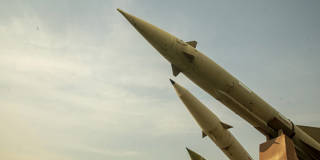SHAHID JAVED BURKI

Is the broader Middle East conflict drawing Pakistan in? The answer hinges on Iran. Not only are its proxies in Gaza, Lebanon, and Yemen keeping regional hostilities at a boil, but it also backs militant groups that have attacked positions in Syria, Iraq, and Pakistan – three countries that are generally friendly toward it (to varying degrees). Recent missile and drone strikes by Iran, a would-be nuclear power, on nuclear-armed Pakistan’s territory are particularly worrying.
Iran’s attacks on Syria, Iraq, and Pakistan are responses to hostile activities that it believes originated within those countries. Iranian strikes in Syria, for example, followed suicide bombings that killed nearly 100 people in the Iranian city of Kerman. In a sense, these episodes were nothing new. Iran and its proxies have been battling the Islamic State (ISIS) for years. Syrian President Bashar al-Assad himself has relied heavily on Iran in fighting ISIS (he also ultimately benefited immensely from US, Israeli, and Turkish offensives against the group).
By contrast, a recent Iranian attack on the Iraqi city of Erbil, the capital of Kurdistan, was intended to punish Israel. As General Amir Ali Hajizadeh of Iran’s Islamic Revolutionary Guard Corps (IRGC) Aerospace Force told Iranian state TV on January 16, Israel’s covert attacks on Iran’s nuclear facilities and assassinations of its nuclear scientists have been planned from a facility in Erbil. “We had to confront this and retaliate in the name of the blood of our martyrs,” he explained.
Similarly, according to Iranian Foreign Minister Hossein Amir-Abdollahian, the strikes on Pakistan’s restive Balochistan province the same day were directed at a training camp for a Sunni extremist group. The Iranians claim the group, Jaish al-Adl, specializes in attacking positions along Iran’s border with Pakistan, and it recently struck a police station in southeastern Iran, killing 11 officers.
Established in 2012, Jaish al-Adl emerged from the remnants of Jundallah, a Sunni militant organization whose strength waned after Iran captured and executed its leader, Abdolmalek Rigi, in 2010. In 2021, the IRGC carried out a cross-border operation to rescue two Iranian soldiers who were being held hostage by the group.
Following the Iranian strike last month, Ahmed Quraishi, a Middle East analyst based in Islamabad, warned that “the Pakistanis [cannot] afford to let this incident pass without a response. But retaliation, whenever it happens, will be swift and will maintain an element of surprise.” That is indeed what happened: On January 18, Pakistan launched air strikes against militant groups in Iran, killing nine people.
Iran and Pakistan have accused each other for years of sheltering militants along their shared 559-mile border. Pakistan has long believed that Iran is supporting separatist groups in Balochistan, and in 2017, it shot down an Iranian drone over the province. But the latest exchange of fire will add to Pakistan’s nervousness. Clearly, Iran believes it can strike its enemies at will. “We are a missile power,” Iranian Defense Minister Mohammad Reza Ashtiani recently told state media. “Where they want to threaten the Islamic Republic of Iran, we will react, and the reaction will definitely be proportionate, tough, and decisive.”
Hence, one goal of Iran’s recent missile strikes is to call attention to its rapidly developing, increasingly sophisticated weapons program. Unveiled only in 2022, the “Kheibar Shekan” used last month is a solid-propellant precision-guided missile with a range of 1,450 kilometers (900 miles), long enough to reach Israel.
Iran has come a long way since it first amassed an arsenal of crude Scud missiles acquired from Libya and North Korea in the 1980s. Today, it designs and manufactures its own missiles (both offensive and defensive), and these are central to its broader military and foreign policies. Having also developed its own missile and nuclear programs, Pakistan harbors no illusions about its neighbor’s growing military power.
Although the Pakistani and Iranian foreign ministers spoke by phone immediately after the Iranian strike, Pakistan nonetheless felt the need to retaliate. And although both sides said they had targeted separatist militant groups that pose cross-border threats, it is hard to believe their claims that the incident is not connected to the conflict between Israel and Hamas. With tensions rising and proxy forces being unleashed across the region, events are becoming ever more difficult to predict.
For now, though, both governments seem anxious to lower the temperature. Amir-Abdollahian has stressed that Iran “targeted only Iranian terrorists in Pakistan,” not Pakistani citizens; and the Pakistanis have justified their own strikes in much the same way. Both sides highlight that they have had friendly relations for decades, and that they intend to return to that status quo. But as long as proxy armies and forces are committed to raising tensions and exploiting the fog of war, no one can dismiss the risk of renewed violence between these two regional powers.
No comments:
Post a Comment